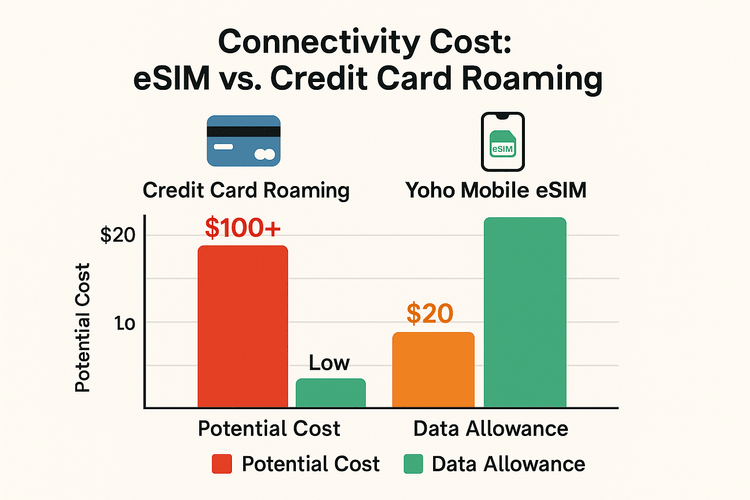Traveling abroad in 2025 should be about exploring new cultures, not deciphering complex phone bills. Many premium travel credit cards, like those from HSBC, offer tempting international roaming packages as a perk. But are they truly the best deal, or is there a smarter way to stay connected? The answer often lies in the hidden details.
This in-depth analysis compares the true cost, convenience, and performance of travel credit card roaming perks against the modern flexibility of an eSIM. Before you jet off, make sure you’re making the most cost-effective choice for your data needs. Ready to ditch surprise fees for good? Explore Yoho Mobile’s flexible eSIM plans today.

Picture by Stephen Phillips - Hostreviews.co.uk on Unsplash
Understanding Travel Credit Card Roaming Perks
At first glance, a credit card that offers a “free” or discounted roaming package seems like the ultimate travel hack. Major banks promote these perks to add value to their premium cards.
How Do They Typically Work?
Cardholders often need to activate the benefit through their banking app or portal. The offer might be a set number of days of free roaming per year or a daily flat rate that’s cheaper than standard operator charges. For example, some HSBC credit cards provide access to roaming data passes in select destinations. The primary appeal is convenience—using your existing SIM card without needing to change anything.
The Hidden Costs and Fine Print
The convenience, however, can come with significant drawbacks. These “perks” are rarely unlimited and are governed by strict fair usage policies. You might find your data speed severely throttled after using just a few hundred megabytes, making it useless for anything beyond basic messaging. Furthermore, the list of supported countries can be surprisingly limited, leaving you unprotected if you take a spontaneous side trip. The biggest shock often comes from out-of-plan charges if you exceed the allowance or use your phone in a non-covered country, leading to the very bill shock you tried to avoid.
The eSIM Alternative: A Modern Connectivity Solution
An eSIM (embedded SIM) is a digital SIM that allows you to activate a cellular plan from a provider without having to use a physical nano-SIM. It’s built directly into your device, and an increasing number of phones support this technology. You can check your device’s compatibility on this eSIM compatible list.
Why eSIMs Are Gaining Popularity
The primary advantage of an eSIM is unparalleled flexibility. You can purchase and install a data plan for your destination right before you leave or even after you’ve landed. There’s no need to find a local store or swap tiny plastic cards. For travelers visiting multiple countries, like a backpacking trip across Southeast Asia from Thailand to Vietnam, a regional eSIM plan offers seamless connectivity without changing settings. With providers like Yoho Mobile, you get transparent, upfront pricing. You pay for the data you need, for the duration you need it, and that’s it.
Ready to experience the future of travel connectivity? Try Yoho Mobile’s free eSIM trial and see the difference for yourself.

2025 Showdown: Credit Card Roaming vs. Yoho Mobile eSIM
Let’s break down how these two options stack up in real-world scenarios. The question of whether HSBC credit card roaming is worth it depends entirely on comparing it to the superior flexibility and cost of an eSIM.
Cost Comparison: A Trip to Europe
Imagine a 14-day trip to Europe, visiting France, Italy, and Germany.
| Feature | Credit Card Roaming Perk | Yoho Mobile eSIM |
|---|---|---|
| Upfront Cost | Often marketed as “free” or a fixed daily rate (e.g., $10/day). | Transparent, upfront price. (e.g., ~$15-20 for 10GB/30 days). |
| Potential Hidden Fees | High overage charges if daily limit is exceeded. | None. You can manually top up if you need more data. |
| Total 14-Day Cost | Could be $0 (with severe limits) up to $140, plus potential overages. | ~$15-20. Dramatically cheaper. |
| Multi-Country Coverage | May not cover all three countries seamlessly. | A single Europe eSIM plan covers the entire region. |
The cost of an eSIM vs. credit card international roaming is clearly in favor of the eSIM. You get more data, wider coverage, and peace of mind for a fraction of the price.
Convenience and Ease of Use
While using your home SIM seems convenient, an eSIM is arguably easier. With Yoho Mobile on iOS, installation takes less than a minute directly from the app after purchase—no QR codes to scan. You can set it up before you even leave home. In contrast, activating a credit card perk can involve navigating a clunky banking app, and if something goes wrong abroad, you’re dealing with bank customer service, not a dedicated connectivity expert. Plus, with Yoho Mobile, you’re always protected by Yoho Care, ensuring you never lose connection even if your data runs out.
Frequently Asked Questions (FAQ)
Is HSBC credit card roaming worth it compared to an eSIM?
For very light users who stay within the strict daily limits and covered countries, it can be a convenient perk. However, for most travelers, an eSIM from a provider like Yoho Mobile offers significantly more data for a much lower cost, with greater transparency and no risk of bill shock.
How to avoid roaming fees with an eSIM?
Using an eSIM is one of the most effective ways to avoid roaming fees. Simply turn off data roaming on your primary physical SIM card before you travel. Then, purchase an eSIM data plan for your destination. Once you land, activate your eSIM and set it as your primary source for cellular data. Your home provider won’t be able to charge you for international roaming.
What is the real cost of eSIM vs credit card international roaming?
The real cost of credit card roaming includes the daily fees (if any) and, more importantly, the high potential cost of overage charges or accidental use in non-covered areas. An eSIM’s cost is transparent and paid upfront. A 10GB plan for Europe might cost $20 with an eSIM, whereas just two days of typical credit card roaming could cost the same for far less data.
Can I still receive calls on my primary number with an eSIM?
Yes. Most modern dual-SIM phones allow you to use an eSIM for data while keeping your primary SIM active for calls and texts. This gives you the best of both worlds: affordable local data via your eSIM and the ability to receive important calls or SMS verification codes on your regular number. Learn more about the benefits of eSIMs.
Conclusion: The Clear Winner for Smart Travelers
While the promise of travel credit card perks is appealing, a detailed 2025 cost analysis reveals that they often hide limitations and potential costs behind a veil of convenience. For the modern traveler who values transparency, flexibility, and affordability, the eSIM is the undisputed winner.
An eSIM empowers you to choose the exact data plan you need, covering single countries or entire regions, all for a clear, upfront price. With Yoho Mobile, you not only get competitive rates but also innovative features like Yoho Care, which ensures you’re never left stranded without a connection.
Don’t let hidden fees and slow data spoil your next adventure. Make the smart switch.
Choose Your Perfect eSIM Plan with Yoho Mobile Today!

